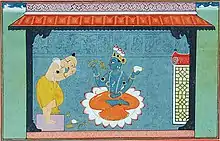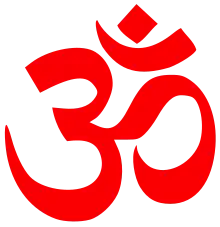Jayatirtha | |
|---|---|
 | |
| Personal | |
| Born | 1345 CE |
| Religion | Hinduism |
| Parents |
|
| Order | Vedanta |
| Philosophy | Dvaita, Vaishnavism |
| Religious career | |
| Guru | Akshobhya Tirtha |
| Successor | Vidyadhiraja Tirtha |
Disciples
| |
| Honors | Ṭīkācārya |
| Part of a series on |
| Vaishnavism |
|---|
 |
| Part of a series on |
| Dvaita |
|---|
 |
| Hinduism portal |
Sri Jayatirtha (Śrī Jaya-tīrtha), also known as Teekacharya (Ṭīkācārya) (c.1345 - c.1388[5][6][7]), was a Hindu philosopher, dialectician, polemicist and the sixth pontiff of Madhvacharya Peetha from (1365 – 1388). He is considered to be one of the most important seers in the history of Dvaita school of thought on account of his sound elucidations of the works of Madhvacharya. He is credited with structuring the philosophical aspects of Dvaita and through his polemical works, elevating it to an equal footing with the contemporary schools of thought.[8] Along with Madhva and Vyasatirtha, he is venerated as one of the three great spiritual sages, or munitraya of Dvaita. Jayatirtha is considered an incarnation of Indra (lord of gods) with avesha of Adi Sesha in the Madhva Parampara.[9][10]
Born into an aristocratic Deshastha Brahmin family,[11] he later adopted the cause of Dvaita after an encounter with the Madhva saint, Akshobhya Tirtha (d. 1365 [12]). He composed 22 works, consisting of commentaries on the works of Madhva and several independent treatises criticizing the tenets of contemporary schools, especially Advaita, while simultaneously elaborating upon the Dvaita thought. His dialectical skill and logical acumen earned him the distinction of Ṭīkacārya or commentator par excellence. [13]
| Part of a series on | |
| Hindu philosophy | |
|---|---|
 | |
| Orthodox | |
|
|
|
| Heterodox | |
|
|
|
Biography
Historical sources on Jayatirtha's life is scant.[4] Most of the information about his life is derived from two hagiographies: Aṇu Jayatīrtha Vijaya and Bṛhad Jayatīrtha Vijaya from his disciple, Vyāsatirtha (not to be confused with Vyasatirtha) and a compilation by Chalāri Saṁkarṣaṇacārya (c. 1700).[14] According to legendary accounts and the hagiographies, Jayatirtha is an incarnation of Indra, the lord of gods with avesha of Adi Sesha and have been miraculously favoured by the Goddess Durga (Mahalakshmi). In the previous birth, Indra incarnated as Arjuna and in next life he incarnated as a Bull and carried the load of the library of Madhvacharya throughout the Madhva's wanderings between Udupi and Badrinath.[9][10][15]
Jayatirtha was born Dhondopant (or Dhondorao) Raghunath into a Deshpande family of nobles belonging to Deshastha Brahmin community in Mangalwedha near Pandarpur present-day in Solapur district, Maharashtra.[14] His father name is Raghunath Pant Deshpande and his mother name is Sakubai. His father was a nobleman of military rank and importance. Dhoṇḍo Pant grew up in affluence, with a certain predilection towards sports, especially horse riding.[11] At the age of twenty, after a chance encounter with the ascetic Akshobhya Tīrtha on the bank of river Bhima, he underwent a transformation which led him to renounce his former life, but not without resistance from his family. After much deliberation, his family relented and he was subsequently initiated into the Dvaita fold by Akshobhya Tirtha, who named him Jayatīrtha.[16] Jayatirtha succeeded Akshobhya as the pontiff in 1365. He composed several commentaries and treatises in the brief span of 23 years between his initiation and death in 1388.
Works
There have been 22 works accredited to Jayatirtha, 18 of which are commentaries on the works of Madhvacharya.[17] Nyaya Sudha, which is a commentary on Madhva's Anu Vyakhyana, is considered to be his magnum opus. Running up to 24,000 verses, it discusses and critiques a variety of philosophers and their philosophies, ranging from the orthodox schools of Hinduism like Mimamsa and Nyaya to heterodox schools like Buddhism and Jainism, arguing in favour of Dvaita. [18] Apart from commentaries, he has authored 4 original treatises of which Pramana Paddhati and Vadavali stand apart. Pramana Paddhati is a short monograph on the epistemology of Dvaita dealing with the pramanas in question, theory of truth and error and validity of knowledge while Vadavali deals with the nature of reality and illusion. [19]
Legacy
Jayatirtha occupies a special place in the history of Dvaita Literature. The lucidity and measured style of his writing coupled with his keen dialectical ability has allowed his works to percolate through time, reinforced by the commentaries of later philosophers like Vyasatirtha, Vijayindra Tirtha, Raghuttama Tirtha, Raghavendra Tirtha, and Vadiraja Tirtha.[20] His masterpiece, Nyaya Sudha or Nectar of Logic, deals with refuting an encyclopaedic range of philosophies that were in vogue at the time. Pereira notes "His monumental Nectar of Logic is one of the pinnacles of Indic theological achievement".[21] Dasgupta remarks "Jayatirtha and Vyasatirtha present the highest dialectical skill in Indian thought".[8]
Brindavan
Jayatirtha took brindavana by going into the state of samadhi in 1388 on the bank of the holy river Kagini in Malkhed.[22][23] Jayatirtha's brindavana (tomb) lies between the brindavanas of Akshobhya Tirtha, and Raghunatha Tirtha. Every year thousands of people attend the aradhana festival from different states of India.[24][25][26]
References
- ↑ Ramchandra Narayan Dandekar (1972). Sanskrit and Maharashtra: A Symposium. University of Poona. p. 44.
Among the authors who wrote on the other schools of Vedānta à mention must first of all be made of Jayatirtha (1365–1388 A. D.). His original name was Dhondo Raghunath Deshpande, and he belonged to Mangalwedha near Pandharpur.
- ↑ Ramesh Chandra Majumdar (1966). The History and Culture of the Indian People: The struggle for empire. Bharatiya Vidya Bhavan. p. 442.
Jayatirtha, whose original name was Dhondo Raghunātha , was a native of Mangalvedhā near Pandharpur.
- ↑ William J. Jackson (26 July 2007). Vijaynagar Visions: Religious Experience and Cultural Creativity in a South Indian Empire. Oxford University Press. p. 145. ISBN 978-0-19-568320-2.
Jaya Tirtha was first named 'Dhondo', and he was the son of Raghunatha, who was a survivor of Bukka's war with the Bahmani Sultanate. Tradition says Raghunatha was from Mangalavede village near Pandharpur. An ancestral house still exists there, and the Deshpandes of Mangalavede claim to be descendents of his family.
- 1 2 Sharma 2000, p. 246.
- ↑ Chang 1991, p. xviii.
- ↑ Sharma 1986, p. xviii.
- ↑ Leaman 2006, p. 177.
- 1 2 Dasgupta 1991, p. viii.
- 1 2 Sharma 2000, p. 456.
- 1 2 Dalmia & Stietencron 2009, p. 165.
- 1 2 Sharma 2000, p. 247.
- ↑ Sharma 2000, p. 208.
- ↑ Sharma 2000, p. 236.
- 1 2 Dalal 2010, p. 178.
- ↑ Vivek Ranjan Bhattacharya (1982). Famous Indian Sages, Their Immortal Messages, Volume 1. Sagar Publications. p. 349.
Jayatirtha is the incarnation of Indra as Arjuna. They cannot have given us anything except the correct interpretation of the Gita. Jayatirtha is a great interpreter and his exposition is unique, his style is profound.
- ↑ Sharma 2000, p. 248.
- ↑ Sharma 2000, p. 249.
- ↑ Sharma 2000, p. 330.
- ↑ Sharma 2000, p. 337.
- ↑ Dasgupta 1991, p. 64.
- ↑ Pereira 1976, p. 123.
- ↑ Maharashtra State Gazetteers, Volume 21. Directorate of Government Print., Stationery and Publications, Maharashtra State. 1960. p. 871.
He took sanyas and came to be known as Jayatirtha. He wrote a number of commentaries on Madhvacharya and came to be known as Tikacharya. He took samadhi at Malkhed.
- ↑ Roshen Dalal (18 April 2014). Hinduism: An Alphabetical Guide. Penguin UK. p. 597. ISBN 9788184752779.
Jayatirtha is credited with twenty-two works, the most important being Nyaya-sudha, a commentary on Madhva's commentary on the Brahma Sutra, known as Anuvyakhyana. His samadhi is located at Malkhed.
- ↑ "Special pujas mark Jayatirtha's aradhana mahotsava at Malkhed". The Hindu. 25 July 2016.
- ↑ "Jayatirtha's aaradhana begins in Kalaburagi district of Karnataka". The Hindu. 17 July 2022.
- ↑ Helmuth von Glasenapp (1992). Madhva's Philosophy of the Viṣṇu Faith. Dvaita Vedanta Studies and Research Foundation. p. 40.
It is said that Jayatīrtha was the head of the Madhvas for 21 years ; when he died the last ceremonies were done to him in Malkhed ; even today the pilgrims visit his samādhi.
Bibliography
- Sharma, B. N. Krishnamurti (2000). A History of the Dvaita School of Vedānta and Its Literature, Vol 1. 3rd Edition. Motilal Banarsidass (2008 Reprint). ISBN 978-8120815759.
- Sheridan, Daniel P (1995). Great Thinkers of the Eastern World. Harper Collins. ISBN 978-0062700858.
- Dasgupta, Surendranath (1991). A History of Indian Philosophy, Vol 4. Motilal Banarsidass. ISBN 978-8120804159.
- Dalal, Roshen (2010). Hinduism: An Alphabetical Guide. Penguin Books India. ISBN 978-0143414216.
- Sharma, B.N.K (2001). Nyayasudha of Sri Jayatirtha (3 vols). Vishwa Madhva Parishad. ASIN B0010XJ8W2.
- Pereira, Jose (1976). Hindu theology: A reader. Image Books. ISBN 978-0385095525.
- Chang, Chen-chi (1991). A Treasury of Mahāyāna Sūtras: Selections from the Mahāratnakūṭa Sūtra. Motilal Banarsidass. ISBN 978-8120809369.
- Sharma, B. N. Krishnamurti (1986). Philosophy of Śrī Madhvācārya. Motilal Banarsidass (2014 Reprint). ISBN 978-8120800687.
- Leaman, Oliver (2006). Encyclopedia of Asian Philosophy. Routledge. ISBN 978-1134691159.
- Dalmia, Vasudha; Stietencron, Heinrich von (2009). The Oxford India Hinduism Reader. Oxford University Press. ISBN 9780198062462.